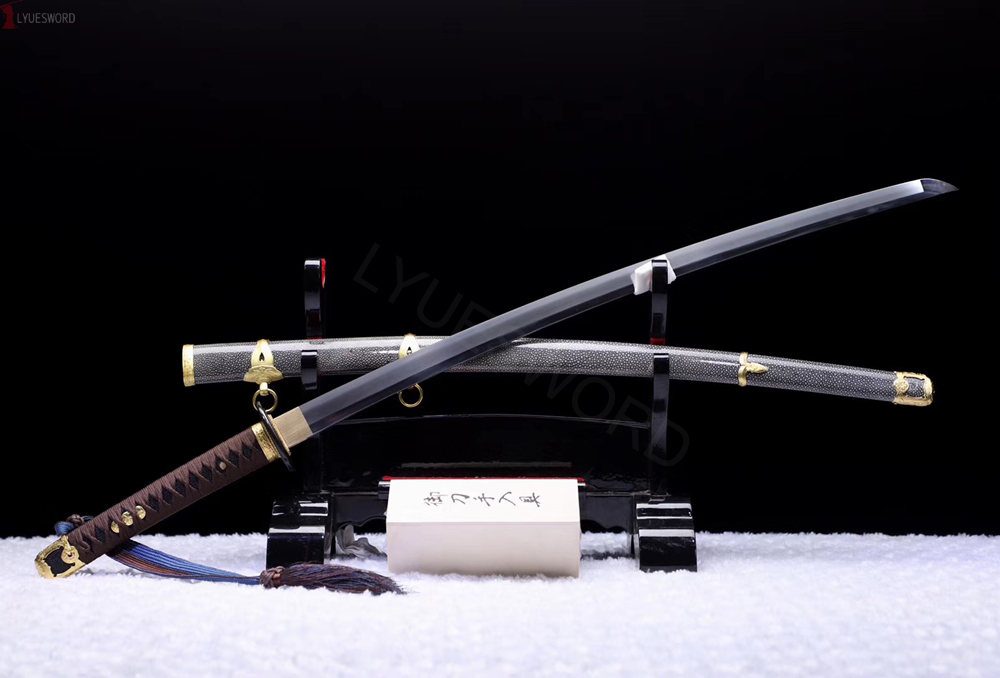By lyuesword | 18 January 2021 | 0 Comments
Exploring the Different Types of Japanese Guntō
The Guntō is type of traditional Japanese sword designed specifically for use in the army and navy. Originating towards the end of the samurai period (1868), it's relatively new compared to other Japanese swords like the katana and wakizashi. There were several different types of guntō produced, however, some of which we're going to explore in this blog post.
Kyu Guntō
Meaning "old sword", the kyu guntō was the first military sword issued to service members of the Japanese Navy and Army. Prior to its invention, handcrafted samurai swords were distributed to military personnel. It's said that Japanese General Murata Tsuneyosh began making the first non-samurai swords for the military, known as kyu guntō.
The kyu guntō featured a wraparound tsuba (guard) and resembled the style of swords produced in American and Europe at the time. It also featured a chrome-plated scabbard, though a full-steel scabbard was introduced around the 1900s.
Shin Guntō
Meaning "new sword," the shin guntō first appeared during the 1930s. Rather than combat, however, however, they were produced and distributed mostly as a status symbol. To receive a shin guntō, a soldier must climb the ranks in the Japanese Navy or Army. Furthermor, the tassels attached to the end of the shin guntō featured different colors depending on the soldier's rank. Generals, for instance, were given kyu guntō with brown-red and gold tassels, while warrant officers were given kyu guntō with brown and blue tassels.
The shin guntō featured a similar style as tachi produced during Japan's Kamakura period (1185 to 1332). Unfortunately, though, it lacked the quality and attention to detail as its tachi predecessor.
Type 94 and 95 Shin Guntō
There were several other swords that followed the original shin guntō: the Type 94 and Type 95 shin guntō. The Type 94 featured a wood and metal scabbard with traditional silk wrapping. The Type 95 was designed specifically for non-commissioned officers (NCOs) and featured brass guards.

The guntō is a piece of Japan's history. With the innovation of Japanese swords, there are also Type 97 and Type 98 shin guntō made by lyuesword.
However, it's safe to say that traditional Japanese swords produced prior to the guntō were higher quality. They were handcrafted by skilled swordsmiths who invested a substantial amount of time and energy into each blade. Many people seek to own and collect the guntō because of its historical significance.
Want a unique sword? Feel free to contact us:
Email: lyuesword@hotmail.com
Website: www.lyuesword.com
Custom Sword Page: www.lyuesword.com/Custom-Sword/customization-options/Create-Your-Own-Swords
Kyu Guntō
Meaning "old sword", the kyu guntō was the first military sword issued to service members of the Japanese Navy and Army. Prior to its invention, handcrafted samurai swords were distributed to military personnel. It's said that Japanese General Murata Tsuneyosh began making the first non-samurai swords for the military, known as kyu guntō.
The kyu guntō featured a wraparound tsuba (guard) and resembled the style of swords produced in American and Europe at the time. It also featured a chrome-plated scabbard, though a full-steel scabbard was introduced around the 1900s.
Shin Guntō
Meaning "new sword," the shin guntō first appeared during the 1930s. Rather than combat, however, however, they were produced and distributed mostly as a status symbol. To receive a shin guntō, a soldier must climb the ranks in the Japanese Navy or Army. Furthermor, the tassels attached to the end of the shin guntō featured different colors depending on the soldier's rank. Generals, for instance, were given kyu guntō with brown-red and gold tassels, while warrant officers were given kyu guntō with brown and blue tassels.
The shin guntō featured a similar style as tachi produced during Japan's Kamakura period (1185 to 1332). Unfortunately, though, it lacked the quality and attention to detail as its tachi predecessor.
Type 94 and 95 Shin Guntō
There were several other swords that followed the original shin guntō: the Type 94 and Type 95 shin guntō. The Type 94 featured a wood and metal scabbard with traditional silk wrapping. The Type 95 was designed specifically for non-commissioned officers (NCOs) and featured brass guards.

The guntō is a piece of Japan's history. With the innovation of Japanese swords, there are also Type 97 and Type 98 shin guntō made by lyuesword.
However, it's safe to say that traditional Japanese swords produced prior to the guntō were higher quality. They were handcrafted by skilled swordsmiths who invested a substantial amount of time and energy into each blade. Many people seek to own and collect the guntō because of its historical significance.
Want a unique sword? Feel free to contact us:
Email: lyuesword@hotmail.com
Website: www.lyuesword.com
Custom Sword Page: www.lyuesword.com/Custom-Sword/customization-options/Create-Your-Own-Swords
Leave a Reply
Your email address will not be published.Required fields are marked. *